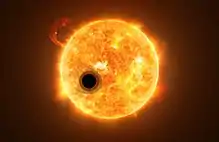WASP-107b
WASP-107b is a super-Neptune exoplanet that orbits the star WASP-107. It lies 200 light-years away from Earth in the constellation Virgo.[4] Its discovery was announced in 2017 and led by D. R. Anderson and a team of colleagues via the WASP-South.[5]
 Artist's impression of exoplanet WASP-107b.[1] | |
| Discovery | |
|---|---|
| Discovered by | D. R. Anderson et al. |
| Discovery date | 2017 |
| WASP-South | |
| Orbital characteristics | |
| 0.0566 ± 0.0017 AU (8,470,000 ± 250,000 km)[2] | |
| Eccentricity | 0[3] |
| 5.7214742 d[2] | |
| Star | WASP-107 |
| Physical characteristics | |
Mean radius | 0.96±0.03 RJ[2] |
| Mass | 0.096±0.005[2] MJ |
Planetary orbit
WASP-107b could not have formed in its current orbit. It likely migrated inward from its birth orbit beyond 1 AU due to interaction with the heavier planet WASP-107c. WASP-107c follows a highly eccentric and inclined orbit with a period of 1088+15
−16 days.[2] WASP-107b itself is on retrograde orbit, strongly misaligned with the equatorial plane of the parent star. Misalignment angle been equal to 118+38
−19°.[6]
Physical characteristics
Helium was discovered in the planet's atmosphere in 2018, making it the first time helium was discovered on an exoplanet.[7] A follow-up observation with Keck in 2020 showed that the helium absorption extends beyond transit-egress.[8][9]
WASP-107b is a super-Neptune gas-giant exoplanet located 200 light years away from Earth in the constellation Virgo.[4] It is roughly the size of Jupiter but less then one-tenth of Jupiter's mass, making it one of the lowest density exoplanets.[2] Its radius is 0.96±0.03 times Jupiter's, making its atmosphere fluffy, and coupled with transiting a moderately bright K star makes it a target for atmosphere characterization.[10] It is eight times nearer its star than Mercury is to the Sun and orbits its star every 5.7 days.[4] With a temperature of 932 °F (500 °C), its atmosphere makes it one of the hottest known exoplanets.[4] Observations of the helium absorption line have shown that the atmosphere of the planet is boiling off the surface, under the fierce irradiation of the star, and is forming a comet-like tail.[8][9]
References
- heic1809 (2 May 2018). "Hubble detects helium in the atmosphere of an exoplanet for the first time". www.spacetelescope.org. Retrieved 4 May 2018.
- Piaulet, Caroline; Benneke, Björn; et al. (2021-01-18). "WASP-107b's Density Is Even Lower: A Case Study for the Physics of Planetary Gas Envelope Accretion and Orbital Migration". The Astronomical Journal. 161 (2): 70. arXiv:2011.13444. doi:10.3847/1538-3881/abcd3c. ISSN 1538-3881.
- "Planet WASP-107 b". Extrasolar Planets Encyclopaedia. 2017.
- Reed, Nola (2 May 2018). "An Exoplanet First! Helium Spotted on Bizarre Comet-Like World". Space.com.
- https://www.aanda.org/articles/aa/pdf/2017/08/aa30439-17.pdf
- The TESS–Keck Survey IV: A Retrograde, Polar Orbit for the Ultra-Low-Density, Hot Super-Neptune WASP-107b, 2021, arXiv:2101.09371
- Witze, Alexandra (2 May 2018). "Astronomers spot helium on exoplanet for first time". Nature. doi:10.1038/d41586-018-05052-w.
- waspplanets (2020-01-22). "Helium reveals the extended atmosphere of WASP-107b". WASP Planets. Retrieved 2020-01-22.
- Kirk, James; Alam, Munazza K.; Lopez-Morales, Mercedes; Zeng, Li (2020-01-21). "Confirmation of WASP-107b's extended Helium atmosphere with Keck II/NIRSPEC". The Astronomical Journal. 159 (3): 115. arXiv:2001.07667. doi:10.3847/1538-3881/ab6e66. S2CID 210838904.
- "First results on the atmosphere of WASP-107b". Wide Angle Search for Planets. September 27, 2017.
External links



